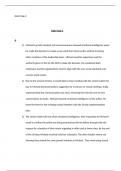Business A Changing
World, 10e Ferrell
Geoffrey Hirt Linda
Ferrell (Instructor's
Manual All Chapters,
100% Original
Verified, A+ Grade)
, Ferrell / Hirt / Ferrell
Instructor’s Manual - Chapter 1
Business
Chapter 1: Business in a Changing World
Use this Instructor’s Manual to facilitate class discussion and incorporate the unique features of the text’s
highlights. Follow-up via the Connect exercises is then encouraged to provide a holistic understanding of the
chapter.
CHAPTER FORECAST
We begin our study of business in this chapter by examining the fundamentals of business and economics.
First, we introduce the nature of business, including its goals, activities, and participants. Next, we describe the
basics of economics and apply them to the United States economy. Finally, we establish a framework for
studying business in this text.
LEARNING OBJECTIVES
LO 1-1 Define basic concepts such as business, product, and profit.
LO 1-2 Identify the main participants and activities of business and explain why studying business is
important.
LO 1-3 Define economics and compare the four types of economic systems.
LO 1-4 Describe the role of supply, demand, and competition in a free enterprise system.
LO 1-5 Specify why and how the health of the economy is measured.
LO 1-6 Trace the evolution of the American economy and discuss the role of the entrepreneur in the
economy.
LO 1-7 Evaluate a small-business owner’s situation and propose a course of action.
LEARN THE TERMS
budget deficit (p. 19) entrepreneur (p. 22) natural resources (p. 8)
business (p. 4) equilibrium price (p. 13) nonprofit organizations (p. 4)
capitalism, or free enterprise financial resources (p. 9) oligopoly (p. 15)
(p. 11)
free-market system (p. 11) product (p. 4)
communism (p. 9)
gross domestic product profit (p. 4)
competition (p. 14) (GDP) (p. 17)
pure competition (p. 14)
demand (p. 13) human resources (p. 8)
recession (p. 16)
depression (p. 17) inflation (p. 16)
socialism (p. 10)
economic contraction (p. 16) mixed economies (p. 11)
stakeholders (p. 5)
economic expansion (p. 16) monopolistic competition (p.
supply (p. 13)
14)
economic system (p. 9)
unemployment (p. 16)
monopoly (p. 15)
economics (p. 8)
1 Instructor’s Manual – Chapter 1 | Ferrell / Hirt / Ferrell: Business © 2016 by McGraw-Hill Education.
This is proprietary material solely for authorized instructor use. Not authorized for sale or distribution in any manner. This
document may not be copied, scanned, duplicated, forwarded, distributed, or posted on a website, in whole or part.
, Ferrell / Hirt / Ferrell
Instructor’s Manual - Chapter 1
Business
KEY TERMS AND DEFINITIONS
budget deficit The condition in which a nation spends more than it takes in from
taxes.
business Individuals or organizations who try to earn a profit by providing
products that satisfy people’s needs.
capitalism (free enterprise) An economic system in which individuals own and operate the
majority of businesses that provide goods and services.
communism First described by Karl Marx as a society in which the people,
without regard to class, own all the nation’s resources.
competition The rivalry among businesses for consumers’ dollars.
demand The number of goods and services that consumers are willing to
buy at different prices at a specific time.
depression A condition of the economy in which unemployment is very high,
consumer spending is low, and business output is sharply reduced.
economic contraction A slowdown of the economy characterized by a decline in spending
and during which businesses cut back on production and lay off
workers.
economic expansion The situation that occurs when an economy is growing and people
are spending more money; their purchases stimulate the
production of goods and services, which in turn stimulates
employment.
economic system A description of how a particular society distributes its resources to
produce goods and services.
economics The study of how resources are distributed for the production of
goods and services within a social system.
entrepreneur An individual who risks his or her wealth, time, and effort to
develop for profit an innovative product or way of doing
something.
equilibrium price The price at which the number of products that businesses are
willing to supply equals the amount of products that consumers
are willing to buy at a specific point in time.
2 Instructor’s Manual – Chapter 1 | Ferrell / Hirt / Ferrell: Business © 2016 by McGraw-Hill Education.
This is proprietary material solely for authorized instructor use. Not authorized for sale or distribution in any manner. This
document may not be copied, scanned, duplicated, forwarded, distributed, or posted on a website, in whole or part.
, Ferrell / Hirt / Ferrell
Instructor’s Manual - Chapter 1
Business
financial resources The funds used to acquire the natural and human resources
needed to provide products; also called capital.
free-market system Pure capitalism, in which all economic decisions are made without
government intervention.
gross domestic product (GDP) The sum of all goods and services produced in a country during a
year.
human resources The physical and mental abilities that people use to produce goods
and services; also called labor.
inflation A condition characterized by a continuing rise in prices.
mixed economies Economies made up of elements from more than one economic
system.
monopolistic competition The market structure that exists when there are fewer businesses
than in a pure-competition environment and the differences
among the goods they sell are small.
monopoly The market structure that exists when there is only one business
providing a product in a given market.
natural resources Land, forests, minerals, water, and other things that are not made
by people.
nonprofit organizations Organizations that may provide goods or services but do not have
the fundamental purpose of earning profits.
oligopoly The market structure that exists when there are very few
businesses selling a product.
product A good or service with tangible and intangible characteristics that
provide satisfaction and benefits.
profit The difference between what it costs to make and sell a product
and what a customer pays for it.
pure competition The market structure that exists when there are many small
businesses selling one standardized product.
recession A decline in production, employment, and income.
socialism An economic system in which the government owns and operates
basic industries, but individuals own most businesses.
3 Instructor’s Manual – Chapter 1 | Ferrell / Hirt / Ferrell: Business © 2016 by McGraw-Hill Education.
This is proprietary material solely for authorized instructor use. Not authorized for sale or distribution in any manner. This
document may not be copied, scanned, duplicated, forwarded, distributed, or posted on a website, in whole or part.





